June 2010 Archives
If you ever get the chance to visit Adelaide in South Australia you should make your way down to Glenelg, the premier seaside suburb in the state. With lovely calm sandy beaches and lots of nice hotels it's a great place to come stay for a few days or just spend a few hours. Glenelg is very well known for the trams which run from the city centre to Glenelg and for the long jetty right at the end of the tram tracks. I dont know what the official numbers are but I'd venture that many thousands of people each week walk the length of the jetty, and that this has been happening since the very first jetty was built on the site in 1859. The original jetty was mostly destroyed in 1948 by a storm and was finally rebuilt at less than 2/3's of it's original length in 1969.
Just near the entrance to the jetty is the Bay Discovery Centre, a volunteer run museum which can be entered with a small donation. Within the Centre is a fascinating display documenting an underwater archaeological dig under the existing jetty and where the jetty used to extend to. This dig recovered more than 5000 artifacts, and as you'd imagine a lot of these were pocket change dropped by happy people strolling the jetty, looking out to sea and enjoying the view of Glenelg as they walk back.

A small selection of the recovered coins
Many thousands of the coins, mostly pre-decimal, are on display at the Discovery Centre along with some informative cards educating people as the types of old money that was used in South Australian and the value it had. Above you can see a small selection of the coins that are on display.

What the Money Could Buy
Above you can see what the money found could have bought a visitor to Glenelg. For example, 9d for a return tram ride from the city to Glenelg, or 9d for a ride on one of the many amusement rides that used to be present where the hotels now stand. On the right of the card you can see some of the different types of coins that were found, it pretty much included all types from all monarchs (although I didn't see any Centenary florins), and extended further back to when British Coinage was the accepted currency in Australia and the former colony of South Australia.

Traders Tokens found Under the Jetty
Interestingly they found a number of traders tokens under the jetty. Other than coin collectors very few people would even know what these were and the Discovery Centre devoted an entire information card to the subject. It included images of the tokens themselves and archival images of the issuing Adelaide merchants.
I had two small children with me on the day, and the older one was pretty much captivated by all the money and was asking all sorts of questions as to the value of the old money which he'd never seen before. It's that sort of interest that gathers new collectors to the hobby. I'd recommend a visit to the Bay Discovery Centre if you're ever in Glenelg and putting aside an hour or so to peer at all the found coins to see if you can spot a key date!
You've typed some of the above words into google and you've found us. Congratulations you're already doing the right thing.
Inheriting a collection or a accumulation of coins and the realisation of 'what to do now?' can be very daunting indeed. Where do you start?
May I suggest the best way to start would be don't be tempted to clean them. They might look a bit dirty or grubby from poor storage or from sitting in the attic or shed but a quick wash and scrub is absolutely the wrong thing to do. May I just say again, the first thing to do is NOT pretty them up for sale. A quick bath or wipe will do more harm than good. A common misconception by the non-collector is that a coin will appear more valuable if it has that wow factor or shine similar to a coin just struck at the mint. The fact is though if you attempt any sort of clean on a coin you will leave a trace and the coin will lose some of it's value. In some cases it will be rendered worthless.
The next thing you need to do is determine if you have an interest in them and will keep them or sell them and move on with your life. Either way you should pick up a copy of Greg McDonald's Pocket Guide to Australian Coins and Banknotes (Macca's) a copy of which sits here permanently on my desk for reference purposes. I'm not saying this is the be all and end all of Australian Coin pricing but it's a place to start and it will give you an idea of the scarcity of a coin, mintage, and a dollar value.
The internet is also a great place to see how much coins are selling for and past sales. Informative information can also be found on this site as well as The Sandpit or Triton .
So you have this box or album of coins in front of you and you really don't know what to do next. Did I mention not to clean them? OK, let's move on.
Picking up a pair of cotton gloves from the supermarket is a great idea and make yourself comfortable at the kitchen table. A piece of felt layed down or a thick table cloth is a great idea so you don't damage the coins any further. Have you heard of "verdigris"? It is a type of copper cancer and once it has taken hold of your coins it's almost impossible to remove and it will spread through the collection. So for starters it's best to remove these affected coins and make a "quarantine area". Now unless any of these are a key date or a high grade they are only worth bullion value -that's the intrinsic value of the metal only. Another form of green that occurs more commonly on silver coins is a film of sticky residue that results from poor storage. This is pvc residue and any pvc in the vicinity of the coins should be quickly discarded.
If your grandfather or great uncle had them sorted in an album then they may be labelled and this chore for you will be just that much easier. Otherwise it's up to you to have a sort through and see if there are any key date years in amongst them. By referring back to your "Macca's" you'll get an idea that if you come across a 1925 penny or a 1932 Florin then you shouldn't let the kids play with Poppy's coins anymore.
If you just don't have an interest in doing this then I would suggest you visit your local coin dealer and get their advice. They'll browse the coins for the key dates or anything special and possibly offer to buy them from you at an agreed price. If you visit one of the larger dealers in your capital city they may hold public auctions every few months and your chance at achieving a higher price for your inheritance might be to consign the coins to their next auction. There are fees associated with this so check with the dealer exactly what these might be. If you dabble with selling on eBay then listing the coins up with a well researched description and great images is the key to selling this way.
I any case I believe education is the key and if you don't know, ask someone who does.
My partner has written a very extensive discussion into NCLT collector coins and their importance in numismatics and the potential there to drive the desires of people into collecting coins. While collecting NCLT was exactly the way I started collecting coins, it certainly wasn't how I first began to admire the coins themselves.
Growing up, my parents collected shiny new coins from change into a jar on the shelf. It was a passive way to enter the coin market but it was the start of the very driven passion for coins that I have. The jar contained fascinating commemorative issues all in perfect condition from change and on occasions I would browse through these just for interest. it wasn't until years later that the real collecting began but this was the conception of the collecting bug inside.
Many collectors out there just simply can't afford to buy a NCLT coin way above face value. What benefit is there really for spending $100 on a face value $10 coin except that it's pretty?
Many young collectors are lured into the market as they simply collect pocket money or coins from their change. A fundamental core value that every child needs to grow into a successful adult is -the ability to save. Putting together a commemorative 50c or $1 collection from change can be very fulfilling and doesn't cost very much and it can be the building block for a future numismatist.
Collecting coins from your change can be very challenging as there are scarce and more common issues. Then of course there's varieties such as die cracks, cuds or planchet problems that one can scour coins for. I know of collectors that commonly get bags of change from banks to browse the coins for these varieties, die differences between years and even rare items such as the 2000 $1/10c mule or a 1966 wavy 2 20c.
I think a lot of collectors get the money bug at a young age and a passion in collecting is the the result. Think about it, how many hobbies can you have where you buy money with money??
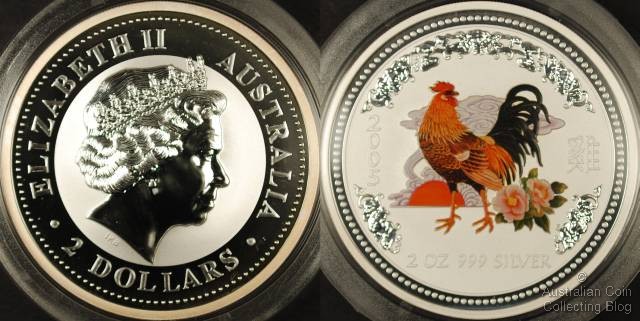
Perth Mint NCLT Issue - 2005 Year of the Rooster 2oz. Silver $2 Coin
This article is continued from Part 1, and Part 2.
7. There's Always Something Happening in the NCLT Market
If you collect pre-decimal coins the amount of news of new releases and discoveries each day is, well, pretty much always.....nothing. Sometimes The Australian Coin and Banknote Magazine might have an article covering some new variety discovery or perhaps a new method of identifying a proof coin by die markers. Hardly exciting stuff and likely only to interest the hard core collector. Consider this blog for example, honestly a lot of the information in here about pre-decimal coins is simply gathered and summarised from other sources. With new releases of NCLT product, new errors and varities being discovered in this new product, and surges in the prices of the secondary market for NCLT there always seems to be something going on. This can be a constant source of interest to the collector as he or she monitors eBay, participates in online coin forums, or scours the latest glossy brochures for the latest releases of interest.
8. NCLT Provides International Exposure to the Australian Coin Market
While the copper nickel square pennies and half pennies of the early 1900's sell for $100,000 dollars or more they barely rate a mention among international coin collectors except for perhaps the most advanced individuals. The 1930 proof penny may well be the one of the most valuable bronze coins in the world but to the average collector of United States coins it remains a complete unknown. However, if you ask that same collector what a silver Kookaburra is there's a better than even chance that he or she will know exactly what it is. The same can probably be said of the Silver Kangaroo released by the RAM. The very popular Kangaroo at Sunset $20 coin is quite well known overseas as are many of the attractive colourized Perth Mint coins. In fact, these same coins are commonly slabbed by US collectors and can easily be found in NGC holder on the United States eBay. It's no surprise, therefore, that when the RAM attends international coin shows that their specially labelled mint sets, proof sets, and fine silver proof sets sell out quickly. Australian NCLT is extremely well designed, manufactured exceptionally well, and packaged in a fashion not often seen overseas, couple this with the uniquely Australian themes often seen on our coins and you can see why our NCLT has a high profile internationally. If you don't believe me take a look at what the US Mint sells as a proof set and compare it with the RAM product. There is simply no comparison.
Conclusions
If you're a collector of NCLT and a hard nosed 'experienced' collector tells you that the RAM product is overpriced rubbish and the Perth Mint colourized coins aren't even real coins just consider this. NCLT is probably responsible for delivering more coin collectors to the hobby than anything else, it provides a relatively low cost means of entering the hobby and allows you to set yourself attainable and inexpensive collecting goals. You can do this while learning valuable lessons about the market value of coins, buying and selling of coins, the importance of coin grading and condition, and all this while allowing you to focus and refine your collecting interests. There are continual new releases onto the market maintaining interest across the whole hobby and this market interest is responsible for delivering reliable profits to coin dealers. The same coin dealers that the hard nosed 'experienced' collector relies on to stock slow moving pre-decimal coins and varieties that he or she is interested in. Put what that 'experienced' collector says out of your mind when you peruse the glossy catalogue of new NCLT releases, you are the future of the hobby, the future mentor to new collectors, the future contributor of articles to magazines, and perhaps the future coin dealer. It's your hobby, your collection, don't let anyone else tell you what you should or shouldn't be doing!
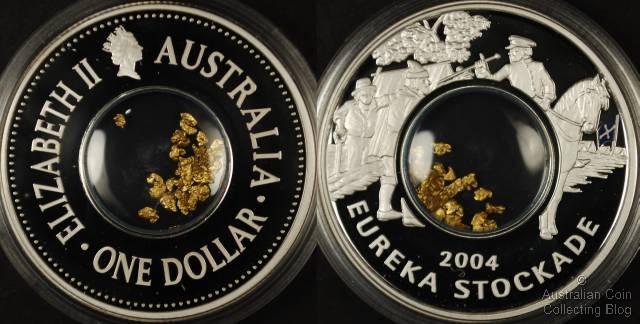
Perth Mint NCLT Issue - 2004 Eureka Stockade Silver Locket Dollar
This article is continued from Part 1, and is concluded in Part 3.
3. NCLT Can Maintain the Interest of New Collectors
As a collector of higher grade pre-decimal coins and quality error coins I purchase new coins for my core collection quite infrequently, perhaps not more that 10-12 coins a year. Personally I am fine with this, but to a new coin collector this slow rate of new acquisitions can be frustrating and result in a loss of interest. However, if, like most new collectors he or she is collecting NCLT then whatever he or she wants to complete a collection is almost always available through a coin dealer or on eBay. Couple this with continual stream of new and interesting products being released by the RAM/Perth Mint and the new collector can easily maintain a high level and interest and enthusiasm for the hobby as they are becoming more and more educated.
4. NCLT Sets ere Obtainable within a Reasonable Time and Budget
I have started some sets of pre-decimal coins I will not finish for many years, other collectors have sets they have been working on for 20-30 years or more. And they are still looking! And even if all the coins for a particular set are readily available the cost is often hugely prohibitive. Take the example of completing a mid-grade penny set, most of the coins can be had in mid to low grades for under $20, while the 1946 and 1925 penny for less than $200. However, the king of pennies, the 1930 in just Fine will set you back $20,000 or more. It's not that they are hard to get, there are a few dozen on the market in any one year, they are just nightmarishly expensive. Obviously the new collector is going to be easily frustrated by taking so long to complete a collection or the huge cost involved and may be lost to the hobby.
Collecting NCLT sets is almost always a lot quicker and a lot less expensive. For example, collecting a full set of Australian dollar coins by mintmark might be the task of a couple of years but the most expensive coin will just be $250 or so for a Victoria Cross dollar and the collector will be able to complete the set just by buying from eBay or from coin dealers. Shorter sets like the coloured wildlife dollars, or all the Australian proof sets, or perhaps the Perth Mint Famous Battles set can be completed much more quickly.
5. NCLT Provides an Inexpensive, Liquid and Educational Market for the New Collector
One of the biggest lessons the new coin collector must learn is that the condition and grade of coins is all important, that there are very few cheap AND good coins available, and that they must learn to focus their collecting habits. NCLT provides a fairly inexpensive and simple method for the new collector to learn key lessons in this area. Firstly, while NCLT by it's nature is almost always top grade, the new collector will find quickly that damaged packaging, missing boxes, and lost Certificate of Authenticities will negatively affect the worth of their collection. Secondly they'll find the sheer scope of NCLT releases means that they probably won't want to or be able to afford to collect everything. With such a strong secondary market for NCLT the new collector can easily dispose of coins that no longer interest them and gain valuable experience with actually selling their coins and understanding the difference between retail value of coins and the value you can actually sell them for. Sometimes the difference can be very shocking AND educational!
6. NCLT Gives Dealers a 'Cash Cow' to Allow them to Remain in Business
Selling a 1930 penny must be a rush, selling an Adelaide pound must be a thrill, and being able to supply a top PCGS graded florin to an advanced collector must be a satisfying and profitable experience. However, while the profits from such sales might be large, the volume is tiny. After all, how many people can afford a 1930 penny? And how many of those actually buy one? Not many. There's no doubt that the RAM and Perth Mint NCLT market is a large one, there's a lot of collectors of this material and new collectors buying it all the time. The market is easily accessible to the average coin dealer, there's no coin grading to worry about, no real storage worries, and a lot fewer eccentric and difficult collectors in the NCLT market. I would imagine that it's really just a pretty easy way of garnering some profits to help cover the bottom line of running a bricks and mortar coin shop. Without those NCLT based profits you might find your average coin dealer just can't survive and the more advanced collector has one fewer source of high grade or interesting pre-decimal coins to fuel his or her addiction.
This article is continued in Part 3.
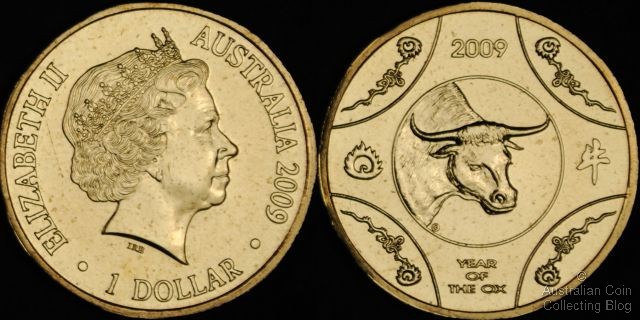
RAM NCLT Issue - 2009 Year of the Ox Dollar
I've found a common thread of opinion among more 'sophisticated' or 'experienced' coin collectors in Australia. It usually goes something along the lines of
"The Royal Australian Mint / Perth Mint produces too many and too expensive NCLT coins for the collector market. These too expensive / too many products are junk, a poor investment, and not collected by any REAL collector"
Throw in Australian Post and their much complained about PNC's and medallion first day covers and you've got a topic that seems to pre-occupy the minds of many 'advanced' Australian coin collectors. Well, I'll go ahead and suggest a divergent opinion to this commonly held belief, I believe that non circulating legal tender coin (NCLT) collector products produced by the RAM, the Perth Mint, and Australia Post are among the most important if not THE most important collectable coin products on the market today. I'll include yearly mint sets and proof sets, off metal sets (like the yearly Fine Silver Silver sets) and the pure collector sets such as the Perth Mint Dangerous Creatures series and the Great Battles of History series. Here's my reasons why I believe this.
1. NCLT Product Brings More Collectors to the Hobby Bar None
Products like mint sets, baby proof sets, proof sets, and wedding sets are not just targeted at coin collectors. Anyone can and do buy them for birthday gifts, to celebrate a wedding, or to remember the birth of a new baby (one of the authors received 2 baby mint sets when his son was born). Themed sets such as the Perth Mint HMAS Sydney coins and the various RAM wildlife coins might be purchased by or for someone who has an interest in these subjects without being particularly interested in coins. One more type of NCLT coin is the bullion coin which may be purchased by those wanting to accumulate gold, or silver or platinum, whether these be the various 1oz silver coins like the RAM's Kangaroo's or the Perth Mint Kookaburra's, through to gold bullion coins like the 'little dinkums' or the 'gold nugget' series.
In each of the three cases above a non coin collector can easily end up with a coin product that was given to them as a gift or as a result of some other interest. Obviously given that a person has a collectable coin product in their possession they have the chance to appreciate the beauty of the coins it contains and to be interested in the information that usually accompanies such a product. A not insignificant percentage of these people would then go on to buy and collect other NCLT products, whether it be a mint set each year, or a baby mint set for each of their children, or additional bullion coins or themed coin sets that they find interesting. Once this has happened a few times, the casual purchaser of coin products has evolved into the basic coin collector and we have a new participant in our great hobby.
2. NCLT Raises Awareness of Coin Collecting to the General Public than any Other Type of Collectable Coin. Bar None.
Grand tours of holey dollars by high end coin dealers are wonderful things to attend, ANDA shows provide a way showing a large selection of pre-decimal coins to several thousand people in just a couple of days, and coin shops are fun to browse and many people pass through their doors each day. However, no matter how many people are drawn to these events you'd have to agree that the vast majority of people who attend each are probably already coin collectors. The various types of NCLT have a greater exposure to the non coin collecting public and raise the profile of our hobby more than any coin show, coin tour, coin shop, coin magazine, or coin auction could ever hope to have. And where is this? In almost every Australia Post office around Australia. Next time you are in a Post Office take a look, there'll be a mint set or two, some Perth Mint colourised coins, perhaps some Lunar dollars, and of course some PNC's and medallion first day covers.
This article is continued in Part 2.
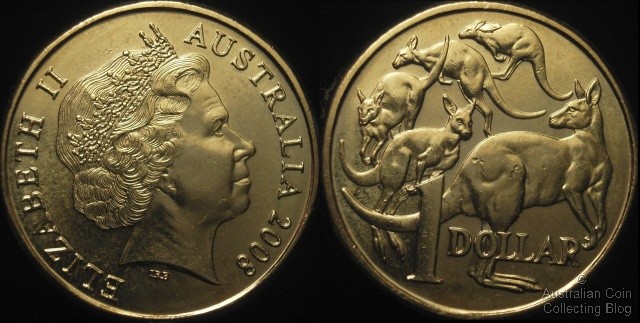 Stuart Devlin's Mob of Roos Australian One Dollar design featuring a Rabbit Ear
Stuart Devlin's Mob of Roos Australian One Dollar design featuring a Rabbit EarSince the introduction of the one dollar coin in 1984 a weak spot on reverse die for the the 5 mob of roos design has resulted in a variety of the dollar coins which you might find in your change. Because of the common weak spot on the die of the mob of roos design in some years a die chip of various sizes and slightly different locations has occurred and cuds are formed on the resulting struck coins.
The very top roo on Stuart Devlin's design may appear to have a small cud on the ear, we might call this a "flea ear". Increase the size of this flea and we have what collectors term the "rabbit ear". These rabbit ears vary from small to huge. A rabbit ear that has disengaged from the ear and ocurred further down the roos back is affectionately termed a "backpack or rucksack" roo. Die weakness has also shown itself at the top most roos mouth causing a "spew roo or spitting roo".
A cud can occur anywhere on a coin design where a failure of the die has ocurred and a part broken or chipped away. Cuds have also ocurred at the base of the tail on the left hand roo causing a "double tail". It is quite common for coins to have rim cuds which are really the same type of error as we're talking about here.
These errors tend to appear on some years more than others. Is this because of a larger production run or a lower number of dies in use for a particular year and therefore there is pressure on the die to stay intact for a longer run of coins? No-one is really sure and after 26 years in production this error continues to occur on the mob of roos dollar coins.
Rabbit Ears can be found only in particular years, notably 1984, 1985 (rarer), 1994, 1998, 2000, 2006 ,2008, 2009, 2010 and 2013 in various sizes. Collectors have noted the spew roo occurring mostly in 2006 but it has been found in other years, with the spew and rabbit ocurring on some coins at the same time.
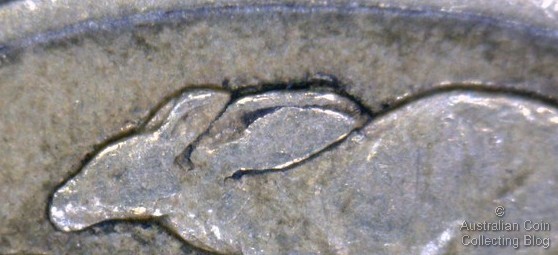 Close-up image of a large Rabbit Ear
Close-up image of a large Rabbit Ear
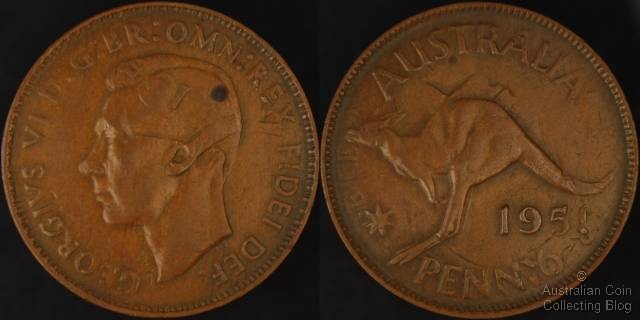
Australia 1951 Penny Flip Over Double Strike Error
In a couple of past entries we talked about double struck coin errors and rotated double struck coin errors. An additional type of double struck coin error is the 'flip over double strike'. This error occurs when a previously struck coin somehow returns to the coining chamber and is re-struck with the previous obverse struck by the reverse dies and the reverse by the obverse dies. This could happen in two different ways, a coin could fall back into the coining chamber immediately after being struck or perhaps a struck coin coin could somehow end up back in the supply of blank planchets being fed into the coining press.
Above you can see an Australian 1951 Penny (with an unfortunate carbon spot) that is a flip over double strike error. The 'obverse' of the coin shows the portrait of George V, however, if you look closely you can see the numerals of a date in the top of his hair, a roo's tail leading backwards from his ear, and the forelegs of a roo in the hair behind his ear. You can see these forelegs in the detail image below.

Detail image of obverse showing roo's forelegs behind Kings ear
The reverse of the coin is a little more spectacular with the King's nose and mouth from the first strike clearly visible above back of the kangaroo. The ghosted image of the top of the King's head runs from the bottom of the kangaroo's back leg in a curved arc around and through the date ending up in the tail. Where it meets the tail you can see the forehead of the King. Below is a detail image of the top of the roo's back showing the King's nose and mouth.
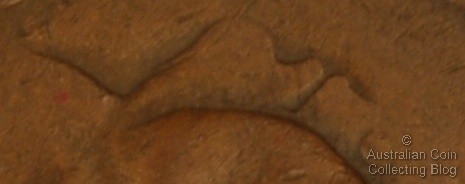
Detail image of reverse showing Kings face above roo's back
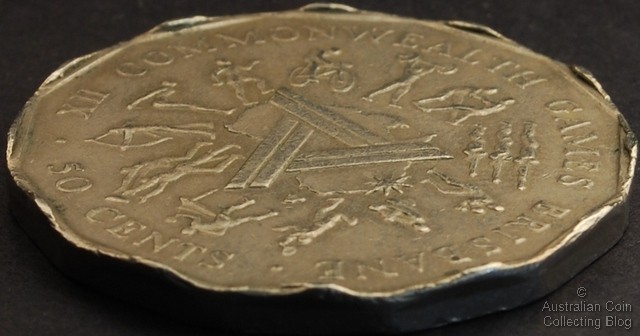 50c Ramstrike
50c RamstrikeA Ramstrike error is caused when the planchet is sitting off-centre or out of alignment with the collar die in the press as the coin is struck. It usually results in a high lip error on the coin but produces a particularly spectacular result when it occurs on a dodecagonal coin issue such as the Australian 50c coin.
This error occurs when the 12 sided blank fails to correctly engage in the press and is struck slightly out of alignment (rotated). This incorrect alignment in the collar die results in a coin struck with protruding metal lugs which can be seen as often sharp, pushed up edges on the coin. Quite a spectacular error when seen in hand.
This error can be mislabelled by dealers or sellers not familiar with this tpe of error as a "scalloped edge" error which is the term for a different type of coin error altogether.
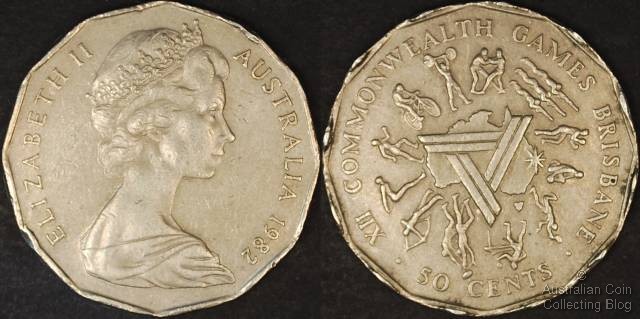 1982 Commonwealth Games 50c Ramstrike
1982 Commonwealth Games 50c Ramstrike
If you're a coin collector and anything like the authors of this blog then before long you'll have a big enough collection that you won't remember where certain things came from, how much they cost you, or when you bought them. Now, you could argue that you're just collecting for the fun of it and you don't really need to know this information, but more than likely you will want to know all of it at some stage. Personally, keeping track of what we've collected is a continual problem to us, we've gone through many iterations of coin storage methods, labeling methods, and ways of cataloging our collections. We thought it might be worth showing a couple of techniques we currently use in our own collections.
Labelling Coins Effectively

Above you can see a pretty rainbow 1963Y penny in an archival safe SAFLIP coin holder. Also in the other sleeve of the holder is an acid free card insert with some coin details noted on it. You can see we've noted the country, denomination, year, and also that the coin happens to be upset. Now all of this may seem pretty obvious when viewing the coin in isolation, but imagine the above coin in an album with a hundred other coins and suddenly you've lost track of individual coin details and it's hard to remember the details of a particular coin at a glance. Also imagine the possibility of your collection being sold by your family without it being annotated correctly, it may not be sold for it's true worth at all. So you can see what the benefit is of safely writing notes on your coins once your have stored them. Probably the only improvement we'd suggest to the label above would be adding a catalogue number to it, so you can cross reference the coin with your coin catalogue. Which we'll talk about now.
Coin Catalogues

Above you can see a screenshot of a small part of the catalogue of one of the authors collection. This one happens to be kept in Microsoft Excel and keeps track of the year, date, mint, grade, purchase date, purchase location, any notes about the coin, and also an image of the coin itself. Each entry in the catalogue has a unique number and these numbers are written on the holder of the actual coin where ever it happens to be stored. This enables a coin to be taken out of a folder or storage box and the catalogue number looked up in the Excel list and all details of the coin are immediately available. Now there are a lot of advantages of using a computer to store your catalogue, it's easy to sort your list of coins, you can search quickly, and you can very easily add or remove entries. There's no reason you have to use a computer though, you could use a note book, a school exercise book or even catalogue cards. Keeping a catalogue can be a real effort though, you must keep on top of it as you add coins to your collection or it can become a lot of work just to catch up. In fact one of the authors only catalogues a small part of their collection because it's just too much work bringing one up to date with the current state of their collection. One important benefit of having a catalogue with images of the coins is for insurance purposes, it is certainly a useful document if your collection happens to be stolen or destroyed in a fire or similar. Touch wood this won't happen though!
So there's just a couple of short tips regarding annotating and cataloging your coin collection. We'd strongly recommend you at least start labeling your collection. Cataloging an entire collection can be a very daunting task but once the initial effort is overcome it is a valuable resource and quite easy to update as your collection grows.
In late May this year PCGS filed a US Federal civil suit against a group of 6 individuals they call 'coin doctors'. I'll write about the suit in a subsequent entry because it should be of interest to any serious coin collector. However, in this entry I thought it would be worth having a look at what coin doctoring actually is, mainly because it's not a term you encounter very often in Australia. In US coin collecting circles it is sadly well known and is beginning to be a real threat to the industry. One very well known US coin expert and dealer has estimated that up to 15% of the PCGS and NGC slabbed pre 1938 coins that pass through his hands have been 'doctored'. Yes, you read that right, these doctored coins have been slabbed by PCGS and NGC. Not deliberately, but because the 'coin doctors' are so skilled at their art that they manage to slip the coins past the graders at these TPG's and get them encapsulated.
So, what is coin doctoring? Well the first thing that springs to my mind is cleaning a coin in a manner to escape detection and thus achieve a higher grade. Another method might be to artificially tone a coin to either give it very attractive colours or to perhaps hide surface defects from the graders eyes. Other methods might be whizzing (tooling down the fields of a coin to remove bag marks and restore lustre), filling holes and bag marks with metal or putty, filing and down and filling edge bumps, or perhaps even chemically treating parts of the coin to frost it and pass the coin off as a proof. However, a quick read of the Civil Suit PCGS filed against the coin doctors shows that coin doctoring has been taken to a much more sophisticated and undetectable level. PCGS defines coin doctoring in a comprehensive manner in the brief, in terms far better than I could ever hope to. Here's what they define it as:
Coin "doctoring" involces the alteration of the appearance of a coin to attempt to increase its value, and may involve, among other things, adding substances to coins (such as, among other things, putty, wax, facial oils, petroleum jelly or varnish); treating coins with chemicals (such as, among other things, potash, sulfur, cyanide, iodine, and bleach); heat treating coins in any way to alter their appearance; re-matting ("skinning") proof gold; "tapping" and "spooning" (ie, physically moving surface metal to hide marks); filing rim nicks; or repairing coins (re-tooling metal)
PCGS go on to describe specific coin doctoring methods used on several coins they've seized that include lasering of coin surfaces and rebuilding of design features using putty or jewelers metal. To give you an idea of how sophisticated these methods are, a big dealer in the USA who knows the six named 'coin doctors' estimates that there are 20 or fewer people in the entire USA who could use the coin doctoring methods PCGS describes in their civil suit.
So, that's coin doctoring. These 'doctors' do it to get a coin into a PCGS or NGC slab, make a quick and obscene profit and move onto the next project. Of course the collector who buys such a coin is left with a dud as the doctoring methods become apparent years down the track as the coin deteriorates and then PCGS or NGC are left to pay for the coin under their guarantee programs. These programs offered by PCGS and NGC will actually buy back a coin at full market value if it is found to be slabbed as a counterfeit or doctored. So you can certainly see the reasons why PCGS is out to get these coin doctors! In the next week or so I'll post a follow up to this article taking a look at the suit that PCGS has filed against the coin doctors.
If anyone's shopping habits are like my own then you'll understand when I say that I will be more drawn to something if I see it in use first. Whether this be on TV advertising where people are using a product or a piece of clothing I like displayed on a shop mannequin. Seeing an item or product displayed or in use helps me understand how it will be used or how it will fit into my lifestyle or even how it might look on me wearing it!
So I thought I'd share with our readers and potential customers of The Purple Penny some of the ways people use and display their The Purple Penny products.
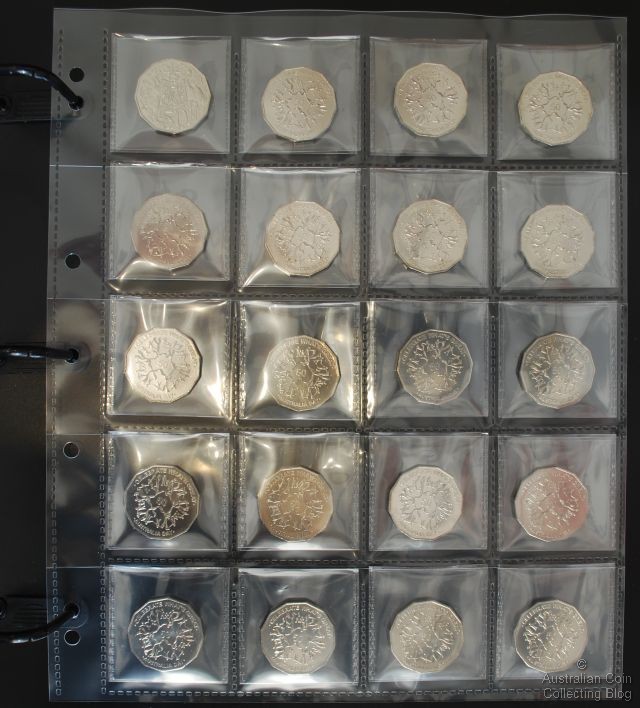 Coins in Saflips in The Purple Penny 20 Pocket Coin Pages
Coins in Saflips in The Purple Penny 20 Pocket Coin PagesAbove is shown the simplest, easiest and most versatile way to house any coins of any size (up to 2x2). When using Saflips you only need one size holder, unlike when you use cardboard 2x2's where you need a variety of different sizes for all the different sized coins. They slip easily into the 20 pocket page and make viewing the coin particularly easy.
 Coins in Cardboard 2x2's in The Purple Penny 20 Pocket Coin Pages in The Purple Penny Album
Coins in Cardboard 2x2's in The Purple Penny 20 Pocket Coin Pages in The Purple Penny AlbumAbove is shown The Purple Penny 20 pocket pages fitting with ease into The Purple Penny Albums. Whether you choose to use our Saflips or Cardboard 2x2's the results are just what you need for the archival storage of your collection long term.
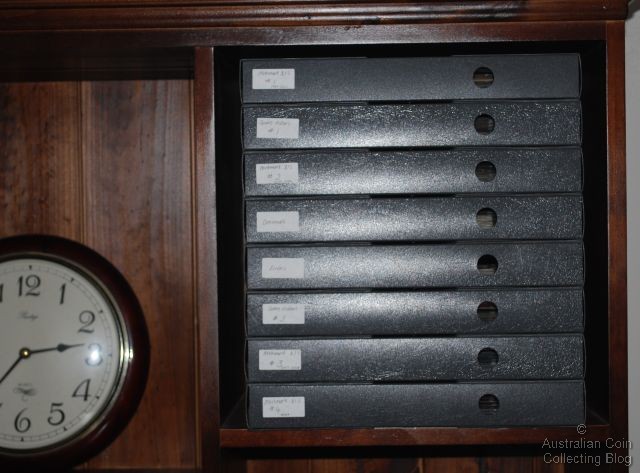 The Purple Penny Albums neatly stored on the Bookshelf
The Purple Penny Albums neatly stored on the BookshelfIf you prefer to have your collection close by for ease of viewing then The Purple Penny Albums stacked on the bookshelf is the right way to go. Storing the Albums horizontal takes the gravitational pressure off the album and pages which will give you longevity out of your albums.
<
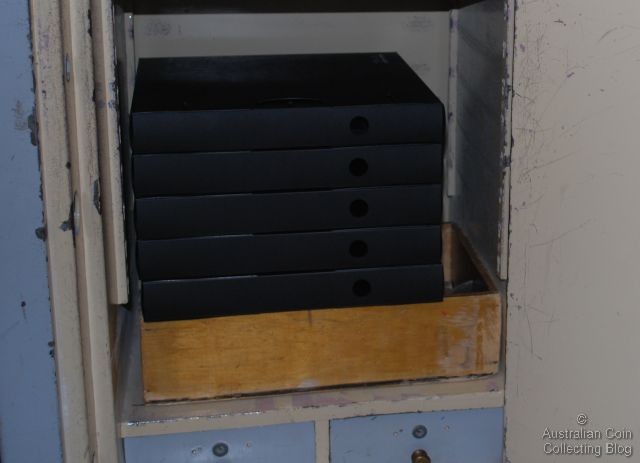 The Purple Penny Albums neatly stored in the Safe
The Purple Penny Albums neatly stored in the SafeIf security is what you prefer then The Purple Penny Albums can fit neatly into the safe to be stored securely and away from the risk of fire and thievery.
Generally we recommend that you can fit around 10 pages of coins into each album which equates to 200 coins per album. Stacking 6 albums (for example) means housing for 1200 coins! Quite a neat way of storing your collection, don't you think?
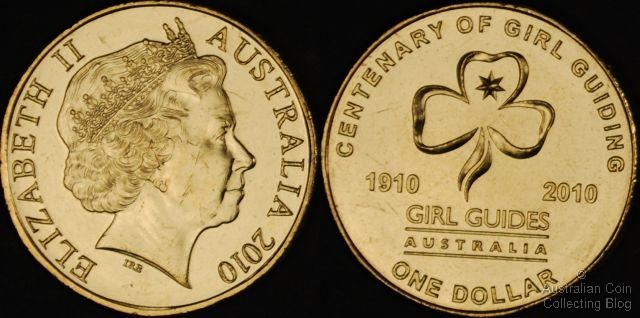 2010 Girl Guide $1
2010 Girl Guide $1Announced in August 2009 this new release 2010 circulating one dollar design commemorates 100 years of the Girl Guides in Australia. This coin will soon be found in your change or can be purchased in RAM wrappered rolls from the Royal Australian Mint or your local coin dealer. A sister coin so to speak for the similar release back in 2008 marking the Scouting Centenary.
Since it's establishment in 1910, a centenary ago, the iconic Girl Guide movement has played a key role in supporting Australian girls and as they develop into confident young women for the past 100 years.
This standard size 25mm, 9 gram, aluminium bronze circulating one dollar coin features the Girl Guide logo, the Trefoil or 3 leaf clover on the reverse surrounded by "Centenary of Girl Guiding One Dollar 1910 2010 Girl Guides Australia". This 3 leaf clover symbolises the Girl Guide promise "To do my duty to God, to serve the Queen and my country, to help other people and to keep the Guide Law". This reverse design is by RAM designer Wojciech Pietranik but noes not bear his initials.
The obverse depicts the standard Ian Rank-Broadley effigy of Queen Elizabeth II.
This coin is being released into circulation, check the mintage in the 2010 Mintage Table. It has also been released in a special PNC jointly with Australia Post for $14.95.
On Wednesday 2nd June 2010 the Royal Australian Mint announced the appointment of a new Chief Executive Officer for the Mint. Mr Ross MacDiarmid will take up the role as of June 7 2010.
The RAM has been under the reigns of Acting CEO Graham Smith since CEO Janine Murphy fell ill and passed away in September 2009.
The new CEO, formerly termed Mint Controller has been on the Mint Advisory Board for the past 5 years and takes up this position after extensive experience in the private sector. He was previously Chief Executive Officer of Dyesol Australia Pty Ltd, a global leader in solar power technology and was also the Chief Executive of Australian Capital Tourism Corporation with a strong focus on marketing and manufacturing.


